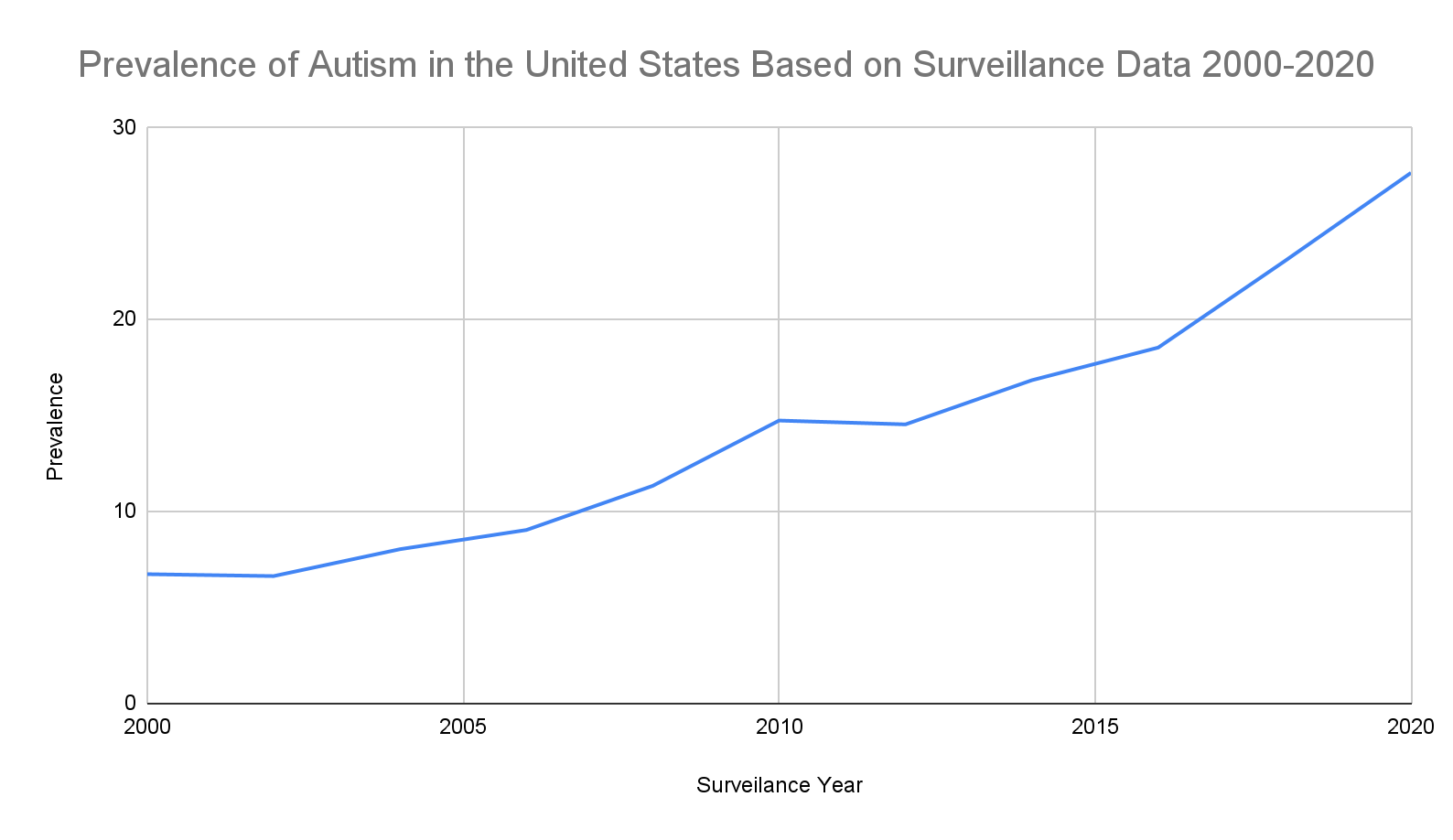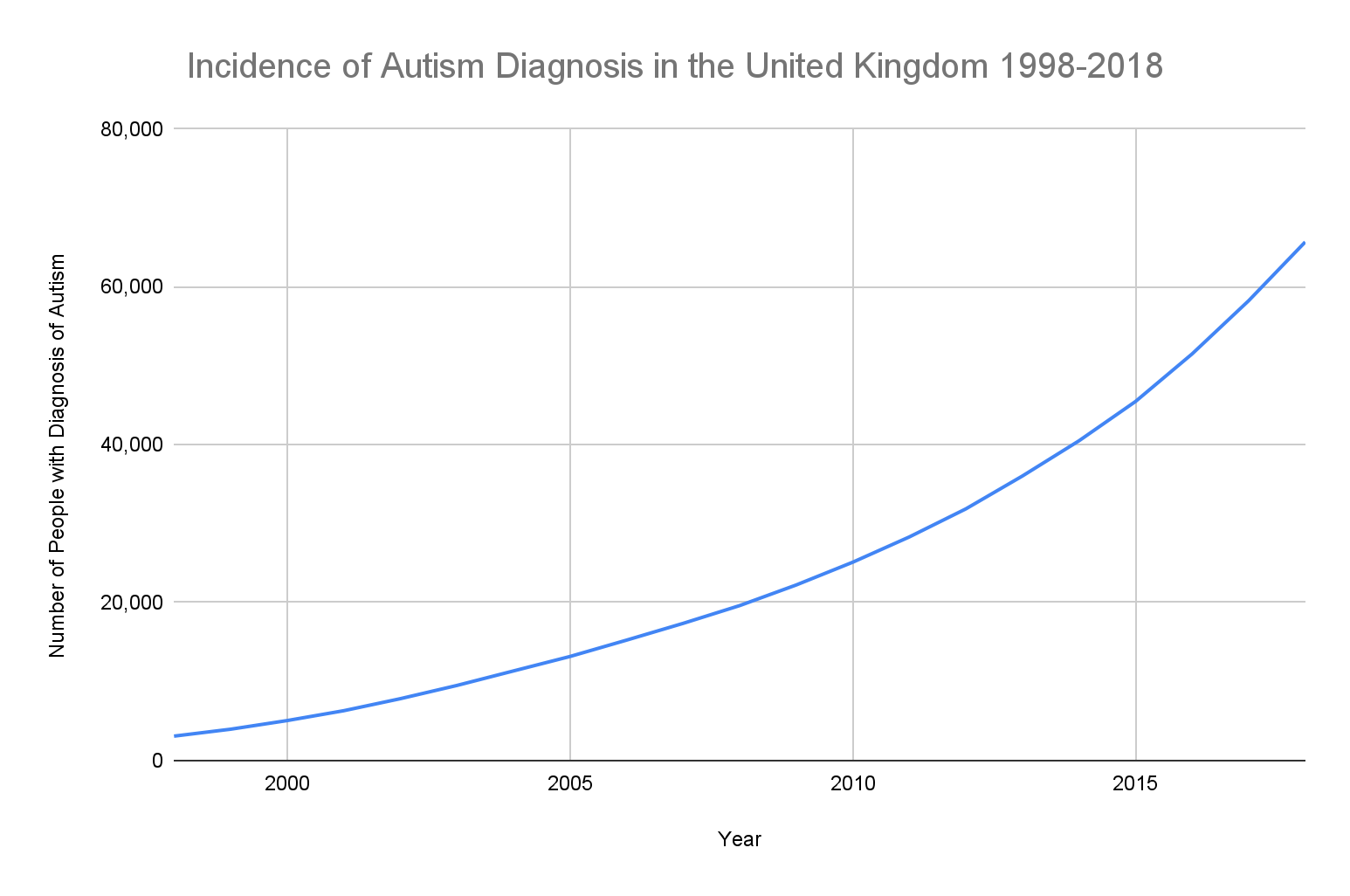Highlights
- In 2021, one in 127 people were estimated to have autism globally, substantially higher than the one in 271 estimated in 2019.
- Autism is significantly more prevalent in boys compared to girls, with a typical male-to-female ratio ranging from 3:1 to 4:1. Some studies suggest the ratio might be closer to 3:1 or even 2:1.
- The highest prevalence of Autism is observed in children and adolescents under 20 years old, making it one of the top ten causes of non-fatal health burden within this age group.
- In the US, the prevalence of Autism among 8-year-old children increased from 1 in 150 in 2000 to 1 in 36 in 2020.
Introduction
Autism – also referred to as autism spectrum disorder ̶ is a group of diverse neurological and developmental disorders. It involves challenges with social communication, repetitive behaviour and restricted interests.
Autism affects how people interact with others, communicate, learn, and behave. Although diagnosis can be made at any age, it is described as a “developmental disorder” because symptoms generally appear in the first two years of life.
The the causative factors of Autism is not completely understood but, available scientific evidence suggests that there are probably many factors including environmental and genetic factors.
Global Autism Statistics
What Percentage of the World Has Autism?
- In a systematic review and meta-analysis of data from 2008 – 2021, the global prevalence of Autism was found to be approximately 0.6%.
- In 2021, the global prevalence of autism was 1 in 127 people which translated to approximately 61·8 million individuals and the global age-standardised prevalence was 788·3 per 100,000 people.
What Percentage of Children Have Autism?
- Globally, the prevalence of autism is estimated to be around 1 in 100 children. This accounts for about 61.8 million million people worldwide and approximately 1% of the world’s population. However, this figure can vary significantly across different studies and regions.
Regions and Countries
- From data between 2008 and 2021, the prevalence rates of Autism differed by continent, with 0.4% in Asia, 0.5% in Europe, 1% in Africa and America and 1.7% in Australia.
- In 2021, high-income countries had a prevalence of 0.79%, while the prevalence of Autism in lower middle-income countries was 0.32%.
- This prevalence varied substantially by region, from one in 65 people in high-income Asia Pacific to one in 163 people in tropical Latin America.
- Qatar is said to have the highest reported Autism rate (151 per 10,000 individuals), followed by the United Arab Emirates (112 per 10,000), and Oman (107 per 10,000).
- On the other end of the spectrum is France with a significantly low rate, France (69 per 10,000).
- Scandinavian countries like Sweden (91 per 10,000) have relatively high rates which has been attributed to an inclusive diagnostic approach and widespread autism-targeted initiatives.
- The ten countries with the highest reported rates of Autism per 10,000 individuals diagnosed are Qatar (151), United Arab Emirates (112), Oman (107), Bahrain (103), Saudi Arabia (101), Kuwait (98), Jordan and Syria (92) and Afghanistan and Palestine (91).
- The ten countries with the lowest reported rates of Autism per 10,000 individuals diagnosed are France (69), Portugal (71), Iceland, Norway, Italy, Germany and Greece 72), and Austria, Belgium, and Spain (73).
In What Age-group is Autism Most Common?
- Autism affects individuals across all age groups, but the prevalence and impact can vary significantly.
- The highest prevalence is observed in children and adolescents under 20 years old, making it one of the top ten causes of non-fatal health burden within this age group.
- Diagnosis can occur across the lifespan, however the average age of diagnosis varies globally, with most studies reporting a mean age between 3 and 10 years old.
- Studies show that the highest rates of diagnosed autism are among children under 5 years old, with a gradual decline in prevalence with increasing age.
- In a meta-analysis of data from 2000- 2020, the prevalence of Autism was found to be higher in children aged between 6 and 12 years (0.82%) compared to children under the age of 5 (0.60%) and those older than 13 years (0.57%).
- In England, the rate of new Autism diagnoses in 2018 was 1 in 250 for 5- to 9-year-olds, compared to 1 in 4,000 for 20- to 49-year-olds.
Is Autism More Prevalent in Boys Than Girls?
- Autism is significantly more prevalent in boys compared to girls, with a typical male-to-female ratio ranging from 3:1 to 4:1. Some studies suggest the ratio might be closer to 3:1 or even 2:1.
- In 2021 global age-standardised prevalence was found to be equivalent to 1064·7 autistic males per 100,000 males and 508·1 autistic females per 100 000 females.
- Females with autism often exhibit different characteristics compared to males. They may have fewer social difficulties or may be better at masking their autistic traits, which can lead to underdiagnosis or misdiagnosis.
- Females are often diagnosed later in life compared to males. This delay can be attributed to the differences in how Autism presents in females and the lack of awareness among healthcare professionals.
United States Autism Statistics
What Percentage of the United States Has Autism?
- Approximately 1 in 36 children in the US have been identified with Autism, which translates to about 2.8% of 8-year-old children.
- Autism is nearly four times more common among boys than among girls, with a prevalence of 4.3% in boys and 1.1% in girls.
- About 3.62% of male adults and 0.86% of female adults in the US have Autism.
- Although Autism occurs in all racial and ethnic groups, its prevalence has been found to be lower among white children than other racial and ethnic groups.
- In 2020, prevalence of Autism was lower among non-Hispanic White children (24.3) and children of two or more races (22.9) than among non-Hispanic American Indian or Alaska Native, non-Hispanic Black or African American (Black), Hispanic, non-Hispanic Asian or Pacific Islander (A/PI) children (26.5, 29.3, 31.6, and 33.4 respectively).
What States Have The Highest Level of Autism?
- Across 11 surveillance sites in 2020, the prevalence of Autism in 8-year-olds ranged from 23.1 per 1,000 in Maryland to 44.9 per 1,000 in California.
- In adults, the prevalence ranged from 0.72% in Arkansas to 0.97% in Virginia for females, and 3.17% in South Dakota to 4.01% in Massachusetts for males.
- Among children aged 4 years the prevalence of Autism in 11 surveillance sites in 2020 ranged from 12.7 per 1,000 children in Utah to 46.4 in California.The overall prevalence was 21.5 and it was higher among boys than girls at every site.
- In 2017, about 2.21% (5,437,988) US adults aged 18–84 years were found to be living with Autism. The prevalence ranged from 1.97% in Louisiana to 2.42% in Massachusetts.
- The states with the greatest number of adults estimated to be living with Autism included California (701,669 cases), Texas (449,631), New York (342,280) and Florida (329,131).
Estimates of Adults with Autism in The United States – 2017
| State | Prevalence among adults ages 18–84 years | Prevalence among females ages 18–84 years | Prevalence among males ages 18–84 years |
|---|---|---|---|
| Alabama | 2.12 | 0.79 | 3.55 |
| Alaska | 2.19 | 0.88 | 3.36 |
| Arizona | 2.29 | 0.84 | 3.76 |
| Arkansas | 2.03 | 0.72 | 3.41 |
| California | 2.36 | 0.92 | 3.82 |
| Colorado | 2.28 | 0.92 | 3.61 |
| Connecticut | 2.37 | 0.84 | 3.99 |
| Delaware | 2.26 | 0.84 | 3.8 |
| District of Columbia | 2.1 | 0.84 | 3.52 |
| Florida | 2.03 | 0.83 | 3.3 |
| Georgia | 2.25 | 0.87 | 3.72 |
| Hawaii | 2.11 | 0.86 | 3.34 |
| Idaho | 2.18 | 0.84 | 3.51 |
| Illinois | 2.32 | 0.9 | 3.79 |
| Indiana | 2.24 | 0.89 | 3.63 |
| Iowa | 2.28 | 0.84 | 3.73 |
| Kansas | 2.19 | 0.83 | 3.57 |
| Kentucky | 2.13 | 0.77 | 3.56 |
| Louisiana | 1.97 | 0.78 | 3.23 |
| Maine | 2.28 | 0.87 | 3.75 |
| Maryland | 2.14 | 0.89 | 3.49 |
| Massachusetts | 2.42 | 0.93 | 4.01 |
| Michigan | 2.17 | 0.85 | 3.54 |
| Minnesota | 2.35 | 0.93 | 3.79 |
| Mississippi | 2.07 | 0.77 | 3.48 |
| Missouri | 2.12 | 0.82 | 3.48 |
| Montana | 2.12 | 0.87 | 3.36 |
| Nebraska | 2.24 | 0.82 | 3.67 |
| Nevada | 2.28 | 0.87 | 3.69 |
| New Hampshire | 2.22 | 0.89 | 3.58 |
| New Jersey | 2.3 | 0.88 | 3.81 |
| New Mexico | 2 | 0.79 | 3.25 |
| New York | 2.25 | 0.92 | 3.67 |
| North Carolina | 2 | 0.82 | 3.26 |
| North Dakota | 2.05 | 0.79 | 3.22 |
| Ohio | 2.11 | 0.83 | 3.45 |
| Oklahoma | 2.13 | 0.8 | 3.49 |
| Oregon | 2.28 | 0.82 | 3.78 |
| Pennsylvania | 2.33 | 0.86 | 3.87 |
| Rhode Island | 2.24 | 0.85 | 3.71 |
| South Carolina | 1.98 | 0.84 | 3.22 |
| South Dakota | 2.02 | 0.85 | 3.17 |
| Tennessee | 2.08 | 0.77 | 3.48 |
| Texas | 2.19 | 0.87 | 3.53 |
| Utah | 2.28 | 0.93 | 3.63 |
| Vermont | 2.12 | 0.84 | 3.44 |
| Virginia | 2.41 | 0.97 | 3.91 |
| Washington | 2.13 | 0.79 | 3.47 |
| West Virginia | 2.07 | 0.83 | 3.33 |
| Wisconsin | 2.23 | 0.83 | 3.65 |
| Wyoming | 2.26 | 0.92 | 3.53 |
Has The Prevalence of Autism Increased Over Time?
- The prevalence of autism has been steadily increasing over the past few decades with prevalence increasing from 2-4/10,000 children as reported in the 1940s, to approximately 4-5/10,000 children, according to the studies that were published in the 1960s and 1970.
- In 2021, one in 127 people were estimated to have autism globally, substantially higher than the one in 271 estimated in 2019.
- In the US, the prevalence of Autism among 8-year-old children increased from 1 in 150 in 2000 to 1 in 36 in 2020.
- In the UK, There was a 787%, exponential increase in recorded incidence of autism diagnoses between 1998 and 2018. This increase in diagnoses was greater for females than males and greatest among adults.
- Increased awareness, changes in diagnostic criteria, and improved identification methods have contributed to the rising prevalence rates observed in recent decades.
Incidence of Autism Based on Gender in the United Kingdom 1998-2018
| Year | Incidence | Male (%) | Female (%) |
|---|---|---|---|
| 1998 | 3,072 | 81.67 | 18.33 |
| 1999 | 3,948 | 82.09 | 17.91 |
| 2000 | 5,043 | 82.31 | 17.69 |
| 2001 | 6,290 | 82.51 | 17.49 |
| 2002 | 7,812 | 82.73 | 17.27 |
| 2003 | 9,488 | 82.62 | 17.38 |
| 2004 | 11,326 | 82.78 | 17.22 |
| 2005 | 13,158 | 82.73 | 17.27 |
| 2006 | 15,230 | 82.67 | 17.33 |
| 2007 | 17,353 | 82.8 | 17.2 |
| 2008 | 19,604 | 82.77 | 17.23 |
| 2009 | 22,217 | 82.62 | 17.38 |
| 2010 | 25,101 | 82.35 | 17.65 |
| 2011 | 28,302 | 82.01 | 17.99 |
| 2012 | 31,858 | 81.76 | 18.24 |
| 2013 | 36,022 | 81.27 | 18.73 |
| 2014 | 40,479 | 80.71 | 19.29 |
| 2015 | 45,462 | 80.07 | 19.93 |
| 2016 | 51,484 | 79.35 | 20.65 |
| 2017 | 58,224 | 78.48 | 21.52 |
| 2018 | 65,665 | 77.49 | 22.51 |
Conclusion
Autism is a lifelong condition, therefore, continued research and awareness will help to ensure that individuals with autism receive the support they need to lead fulfilling lives.
References
https://www.autism.org.uk/advice-and-guidance/what-is-autism
https://www.psychiatry.org/patients-families/autism/what-is-autism-spectrum-disorder
https://www.who.int/news-room/fact-sheets/detail/autism-spectrum-disorders
https://www.learningdisabilitytoday.co.uk/news/global-prevalence-of-autism-hits-over-60-million/
https://worldpopulationreview.com/country-rankings/autism-rates-by-country
https://www.datapandas.org/ranking/autism-rates-by-country
https://www.cdc.gov/autism/data-research/index.html
https://www.nimh.nih.gov/health/statistics/autism-spectrum-disorder-asd
Zeidan J, Fombonne E, Scorah J, et al. Global prevalence of autism: A systematic review update. Autism Res. 2022;15(5):778-790. https://doi.org/10.1002/aur.2696
The global epidemiology and health burden of the autism spectrum: findings from the Global Burden of Disease Study 2021. https://www.thelancet.com/journals/lanpsy/article/PIIS2215-0366(24)00363-8/fulltext#
Autism in England: assessing underdiagnosis in a population-based cohort study of prospectively collected primary care data O’Nions, Elizabeth et al. The Lancet Regional Health – Europe, Volume 29, 100626 https://www.thelancet.com/journals/lanepe/article/PIIS2666-7762(23)00045-5/fulltext
Maenner MJ, Warren Z, Williams AR, et al. Prevalence and Characteristics of Autism Spectrum Disorder Among Children Aged 8 Years — Autism and Developmental Disabilities Monitoring Network, 11 Sites, United States, 2020. MMWR Surveill Summ 2023;72(No. SS-2):1–14. DOI: http://dx.doi.org/10.15585/mmwr.ss7202a1
Shaw KA, Bilder DA, McArthur D, et al. Early Identification of Autism Spectrum Disorder Among Children Aged 4 Years — Autism and Developmental Disabilities Monitoring Network, 11 Sites, United States, 2020. MMWR Surveill Summ 2023;72(No. SS-1):1–15. DOI: http://dx.doi.org/10.15585/mmwr.ss7201a1
Russell, G., Stapley, S., Newlove-Delgado, T., Salmon, A., White, R., Warren, F., Pearson, A. and Ford, T. (2022), Time trends in autism diagnosis over 20 years: a UK population-based cohort study. J Child Psychol Psychiatr, 63: 674-682. https://doi.org/10.1111/jcpp.13505


